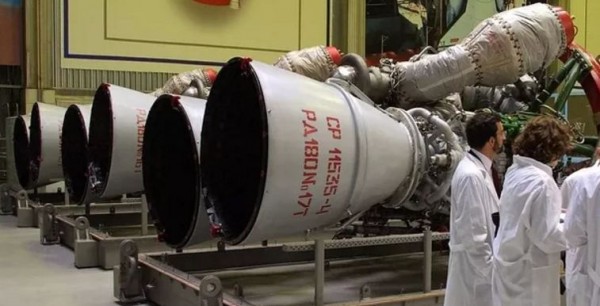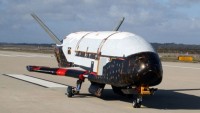US will Stop Using Russia’s RD-180 Rocket Engine for Atlas V Launch Vehicles
| Arthur Dominic Villasanta | | Apr 04, 2017 09:52 AM EDT |
(Photo : TASS) Russia's RD-180 rocket engines.
The United States will stop buying Russia's RD-180 rocket engine that powers the Atlas V launch vehicle from United Launch Alliance (ULA), a situation that's becoming more scandalous as diplomatic ties with Russia plunge from worse to worst.
Each Atlas V rocket uses the Russian-built RD-180 engine that burns kerosene and liquid oxygen to power its first stage. Atlas V is a heavy-lift launch vehicle capable of carrying over 18,000 kilograms into low Earth orbit (LEO) and is widely used by the U.S. Air Force to launch military satellites.
Like Us on Facebook
The United States Congress has set Dec. 31, 2022 as the end date for use of the RD-180 engine.
The sharp deterioration in U.S.-Russia ties after Russia's invasion and annexation of the Crimea in March 2014 compelled ULA to looks elsewhere for a replacement for the RD-180. Studies recommended the Atlas V be replaced by a new launch vehicle named Vulcan powered by American-made boosters.
Vulcan's first stage booster will be the Aerojet Rocketdyne AR1 rocket engine still being developed.
The heavy-lift Vulcan has been in the works since 2014 by ULA and is being funded by a public-private partnership with the U.S. government. ULA expects the first launch of the new rocket to occur no earlier than 2019.
Aerojet Rocketdyne's AR1 will be able to power both the Vulcan and the Atlas V. AR1 develops 550,000 pounds of thrust and uses the same propellant as the RD-180.
"We're on the path we laid out two years ago on schedule. We'll have a certified production engine coming off a production line, which we have outside of Los Angeles right now, in 2019," said John Schumacher, Aerojet Rocketdyne's vice president of Washington operations.
"Depending on the pace of integration with ULA and the pace they're moving on with Vulcan or Atlas, it's ready for integration --the work can start ahead of that -- but it's a 2019, 2020 proposition."
Aerojet Rocketdyne has built full scale flight type components for Vulcan and conducted several hundred component tests in advance of a critical design review next month.
Apart from ULA, the Air Force plans to retain the services of SpaceX as one of its two primary launch providers.
SpaceX uses the Merlin 1D, a homegrown rocket engine, for its Falcon 9 and Falcon Heavy launch vehicles. The company, however, is requesting government funding to help pay for the development of the Raptor, its next-generation methane-fueled rocket engine that could power Falcon 9, Falcon Heavy and the planned Interplanetary Transport System launch system.
TagsUnited States, Russia, RD-180 rocket engine, Atlas V, United Launch Alliance, ULA, Vulcan, Aerojet Rocketdyne, AR1 rocket engine
©2015 Chinatopix All rights reserved. Do not reproduce without permission
EDITOR'S PICKS
-

Did the Trump administration just announce plans for a trade war with ‘hostile’ China and Russia?
-

US Senate passes Taiwan travel bill slammed by China
-

As Yan Sihong’s family grieves, here are other Chinese students who went missing abroad. Some have never been found
-

Beijing blasts Western critics who ‘smear China’ with the term sharp power
-

China Envoy Seeks to Defuse Tensions With U.S. as a Trade War Brews
-

Singapore's Deputy PM Provides Bitcoin Vote of Confidence Amid China's Blanket Bans
-

China warns investors over risks in overseas virtual currency trading
-

Chinese government most trustworthy: survey
-

Kashima Antlers On Course For Back-To-Back Titles
MOST POPULAR
LATEST NEWS
Zhou Yongkang: China's Former Security Chief Sentenced to Life in Prison

China's former Chief of the Ministry of Public Security, Zhou Yongkang, has been given a life sentence after he was found guilty of abusing his office, bribery and deliberately ... Full Article
TRENDING STORY

China Pork Prices Expected to Stabilize As The Supplies Recover

Elephone P9000 Smartphone is now on Sale on Amazon India

There's a Big Chance Cliffhangers Won't Still Be Resolved When Grey's Anatomy Season 13 Returns

Supreme Court Ruled on Samsung vs Apple Dispute for Patent Infringement

Microsoft Surface Pro 5 Rumors and Release Date: What is the Latest?












